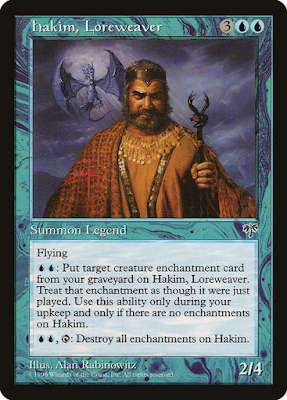Tuesday, April 26, 2022
Magic: The Gathering: The Worldbuilding: The Writeup (5 of 8)
Sunday, April 24, 2022
MtGtWtW: Interlude
Appendix: some quodlibetical notes about the anatomy and physiology of a mythos, apropos the closing remark of the last post.
Monday, April 18, 2022
Magic: The Gathering: The Worldbuilding: The Writeup (4 of 8)
This is going to be a long one, but I want to get the Weatherlight Saga out of the way. It's sort of like 1990s superhero comics: full of iconic characters and landmark events, but much more impressive in retrospect than in its execution.
Monday, April 11, 2022
Magic: The Gathering: The Worldbuilding: The Writeup (3 of 8)
I just finished Elden Ring and you made me realize it's basically the same thing as Magic, except item descriptions are the equivalent of cards. It's just a bunch of free-floating "lore" without any plot or meeting any of the mentioned characters, give or take a few boss fights. Is raw lore that interesting? I suppose it's a nerd thing?
That's...that's exactly right. I've never played Elden Ring or any of Hidetaka Miyazaki's other games (and yes, I know, I'm all the poorer for it), I did play Blasphemous earlier this year, which I understand is a Souls/Metroidvania hybrid.
Blasphemous' story, as communicated during the occasional moments of dialogue, explains what's happening as though the player were already acculturated to Cvstodia and didn't need to be brought up to speed on the Miracle, the Church, or the Brotherhood of the Silent Sorrow, and the effect is that you're operating in the dark for most of the game. The descriptions of the items you collect supply fragmentary information about the land's history, its people, the origins of its monsters, its morbid religion, and the depravity of its leaders. Some of it is important; a lot of it is trivial. But it helps a game that would otherwise be an above-average Metroidvania romp with a unique and brilliantly realized aesthetic tunnels deep into your brain. You're presented with a scenario and you want to make sense of it, to create meaning from the patterns with which you're presented, and you can only make progress by being proactive. Blasphemous doesn't tell you its story; it leaves pieces of it lying around for the player to put together so they can make their own conjectures and draw their own conclusions.
This is precisely how Magic: The Gathering did things in its fledgling years. You collected and played with the cards, and for the most part, when you opened a booster pack of sifted through your collection, you were more interested in how a card functioned than what it revealed about any imaginary world. But you were still looking at the art and reading the flavor text; the ambiance of the setting and the story (even when the story was rudimentary) was inescapable. The same compulsion to make sense of a pattern was apt to assert itself—and, yes, I suppose nerds are particularly susceptible to this sort of thing.
Monday, April 4, 2022
Magic: The Gathering: The Worldbuilding: The Writeup (2 of 8)
If I had to rank my favorite Magic: The Gathering artists, Amy Weber and her buoyant, diagrammatic compositions would be somewhere in the top three. What exactly are we seeing in Curse of Marit Lage? How does it relate to the card's in-game effect? Who knows! But it sure is fun to look at.
I really miss old Magic art. In the mid-1990s, Wizards of the Coasts' artist coterie was full of people whose work was impossible to mistake fom anyone else's. Amy Weber, of course. Richard Kane Ferguson. Kaja and Phil Foglio. Drew Tucker. Rebecca Guay. Andi Rusu. Even that deranged nazi fuck Harold McNeill. In its early years, Magic's signature "look" was a composite of diverse art styles, imbuing the fantasy world depicted in the cards and the aesthetic experiences of the game they're used in with a touch of surreality, of the protean, of...well, magic.
Scrolling through these writeups and just looking at the card images is sort like watching a time-lapse video of a flower blooming or a carcass decomposing. By the time we get to the end of the decade, the art doesn't look very much at all like it did at the beginning. After another eight years, the difference between Mark Poole's Counterspell and Jason Chan's Counterspell is as stark as the contrast between how Jack Kirby and Jim Lee drew the X-Men. Nowadays, Magic art is sleek, consistent, and exquisitely polished—but not as much fun as it was when it was still a hodgepodge, and before Wizards ran its art department like a factory.
...Anyway. Let's get on with it.





